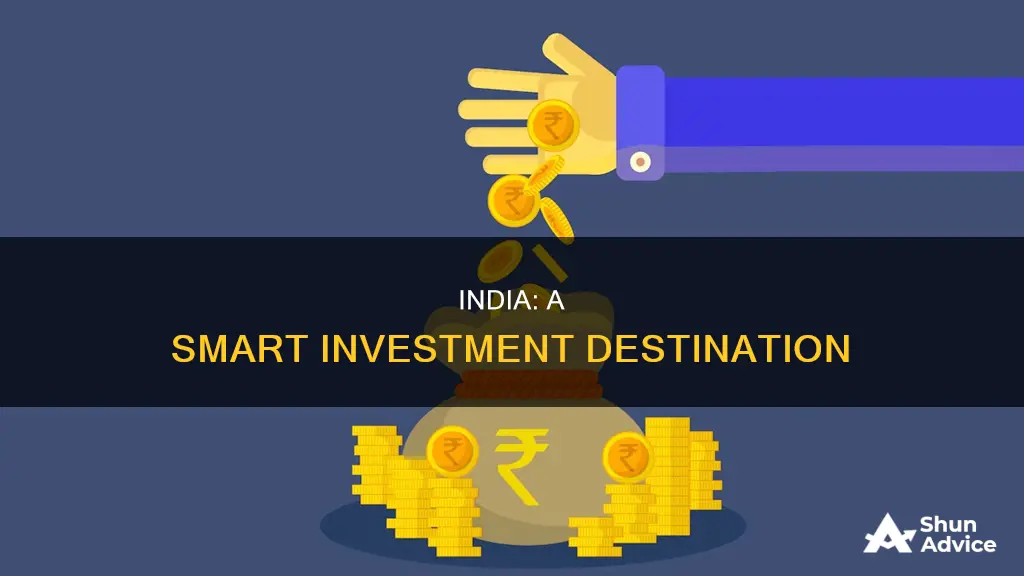
India is an attractive prospect for investors for a variety of reasons. Firstly, it has a large and deep equity market, with the Bombay Stock Exchange (BSE) in Mumbai being the oldest in Asia. India's economy is also one of the fastest-growing in the world, with a projected GDP growth of 6.5% in the fiscal year 2024-25. The country has a large consumer base, rising urban incomes, and the world's largest young population, which is expected to drive business expansion. India's improving infrastructure, diverse stock markets, and favourable demographics further enhance its investment appeal. Additionally, India's equity markets have traditionally exhibited low correlation with other major stock markets, making it a potentially attractive option for investors looking to diversify their portfolios.
What You'll Learn
- India has one of the world's fastest-growing economies and is projected to become a $5 trillion economy by 2025
- India has the world's largest youth population, with 42% of the population expected to be urbanised by 2030
- India's economy is supported by a STEM-focused educational system, with 34% of graduates specialising in STEM subjects
- India's stock market is large, deep, and liquid, with total market capitalisation exceeding $4.3 trillion
- India's government is pro-growth, with a focus on supporting economic growth, reducing the fiscal deficit, and improving companies' ease of doing business

India has one of the world's fastest-growing economies and is projected to become a $5 trillion economy by 2025
India is one of the world's fastest-growing economies, with an estimated GDP growth of 8.2% in 2023-24. It is projected to become the world's third-largest economy with a GDP of $5 trillion by 2025 to 2028, and $7 trillion by 2030. This growth is attributed to various factors, including structural reforms, a large young consumer market, a STEM-focused educational system, and strong equity markets.
India's economic growth is driven by several structural factors, including demographic trends, digitalization, and infrastructure development. The country has the largest young consumer market globally, with an estimated 360 million consumers below the age of 30 by 2030. This presents significant opportunities for businesses, particularly in sectors such as technology and pharmaceuticals. Additionally, India's digital infrastructure is expanding to meet the needs of its growing number of young, urban consumers. The country already accounts for 43% of digital real-time payments worldwide.
The Indian government has also made significant investments in infrastructure, such as doubling its national highway network to 155,000 km in the last decade. The National Infrastructure Pipeline, launched in August 2020, includes over 9,700 projects across various sectors, with a total investment of over $3 trillion. These projects focus on sectors such as energy, roads, urban development, and railways, which will further enhance India's economic growth and improve international competitiveness.
Another critical factor contributing to India's economic growth is its STEM-focused educational system. India produces a high percentage of STEM graduates, with 34% of its graduates in STEM fields, higher than many other countries. This has led to a highly skilled workforce, driving innovation, employment opportunities, and wealth creation. Additionally, many engineers and scientists working for US IT/software companies are from India, highlighting the country's strong talent pool.
India also has strong equity markets, with the Bombay Stock Exchange (BSE) in Mumbai being the oldest in Asia. The depth and diversity of Indian stock markets offer a wide range of investment opportunities. The total market capitalization of the Indian equity market exceeds $4.3 trillion, making it the fifth-largest worldwide and the second-largest among emerging markets. Indian equities have outperformed global equities and emerging market equities over the last three years, with an impressive return of 46%.
In summary, India's economic growth is driven by various factors, including structural reforms, a large young consumer market, a STEM-focused educational system, and strong equity markets. The country's rapid economic growth and favourable investment climate make it an attractive destination for investors seeking long-term growth opportunities.
Smart Investing Guide: 10 Lakhs in India
You may want to see also

India has the world's largest youth population, with 42% of the population expected to be urbanised by 2030
India has the largest youth population in the world. According to the United Nations Population Fund, India will continue to have one of the youngest populations in the world until 2030. The country's population is expected to rise from 1.21 billion in 2011 to 1.52 billion in 2036, an increase of 25.7% in 25 years. By 2027, India is likely to have the world's largest workforce, with one billion people aged between 15 and 64. This large, young population will contribute significantly to India's growing consumer base.
The median age in India is 28.2 years, or 28.4 years according to another source. By 2030, it is estimated that around 42% of India's population will be urban, up from 31% in 2011. This presents a demographic window of opportunity, or a "youth bulge", that will last until 2025. India's youth face several development challenges, including access to education, gainful employment, gender inequality, child marriage, youth-friendly health services and adolescent pregnancy. However, with investments in their participation and leadership, young people can transform the social and economic fortunes of the country.
India's large consumer base, rising urban incomes, and the aspirations of the world's largest young population are contributing to the country's robust economic trajectory. India's economy is on track to reach 6.5% growth in the fiscal year 2024-25 and will hit 7% in 2026, according to the latest estimates from S&P Global. India is set to overtake China's growth forecast of less than 5% in 2024. Even by the IMF's conservative estimates, India will emerge as the world's third-largest economy by 2027, surpassing Japan and Germany, with a GDP exceeding US$5 trillion.
Building a Balanced Investment Portfolio: An Example Guide
You may want to see also

India's economy is supported by a STEM-focused educational system, with 34% of graduates specialising in STEM subjects
STEM is an acronym for Science, Technology, Engineering, and Mathematics. The educational approach was introduced in 2001 by the US National Science Foundation to address global issues through critical inquiry and rational deduction. STEM education goes beyond traditional academic subjects by providing practical knowledge and demonstrating the real-world applications of the techniques gained in these domains.
India has recognised the importance of STEM education and has actively incorporated it into its educational framework. This proactive strategy equips Indian students with the skills required to succeed in the modern workforce and helps them flourish in an ever-changing global marketplace. STEM graduates have better employability prospects, with international agencies predicting that 80% of future jobs will require some form of maths and science skills.
The Indian government has implemented several initiatives to strengthen STEM education in the country. For example, the Atal Innovation Mission has established over 8700 Atal Tinkering Labs, with 60% of these located in government schools, providing students with hands-on learning opportunities and innovation skills development. Additionally, the National Education Policy (NEP 2020) aims to achieve universal schooling and enhance the quality of education for approximately 20 million students.
Furthermore, India has the third-largest group of scientists and technicians in the world. This highly skilled workforce contributes significantly to the country's economic growth and development. STEM education plays a crucial role in fostering innovation and enhancing scientific literacy, making it a key factor in India's economic growth and competitiveness.
In conclusion, India's STEM-focused educational system is a vital component of its economy. By producing a highly skilled workforce, the country is well-positioned to drive innovation and secure its economic future. The government's initiatives and investments in STEM education demonstrate its commitment to raising well-rounded and forward-thinking youth, which will have a positive impact on India's economy in the years to come.
Understanding Diverse Investment Portfolio Types and Their Benefits
You may want to see also

India's stock market is large, deep, and liquid, with total market capitalisation exceeding $4.3 trillion
India's stock market is one of the largest and deepest in the world, with a total market capitalisation of over $4.3 trillion as of December 2023. This makes it the fifth-largest market worldwide and the second-largest among emerging markets, after China.
The Bombay Stock Exchange (BSE) in Mumbai, founded in 1875, is the largest and oldest exchange in India and Asia. Combined with the National Stock Exchange of India (NSE) and other local exchanges, India's stock market boasts a long-established equity culture.
The market capitalisation of Indian equities is equivalent to 70% of the Japanese market capitalisation and 63% of the combined market capitalisation of the exchanges within Euronext. The weight of MSCI India accounts for approximately 16.3% of the total market cap of MSCI Emerging Markets, a proportion that has steadily grown over the past decade.
Over 170 stocks listed on Indian exchanges have a market capitalisation of over $5 billion, the fourth-highest figure worldwide. These stocks have a high level of daily turnover, with over 250 stocks averaging a daily turnover of more than $10 million. This level of liquidity is surpassed only by the Japanese, US, and Chinese equity markets.
India's stock market has been on a strong upward trajectory, outperforming global equities and emerging market equities over the last three years. In the 20 years before the Covid-19 pandemic, India delivered an annualised return of 8.9%, making it the only market globally that comes close to matching the US over the same period, even in USD terms.
The strong performance of India's stock market is driven by improving fundamentals at Indian companies and their ability to generate and retain profits for shareholders. India's stable political system and consumption-driven economy, which is one of the fastest-growing among major nations, also contribute to the market's attractiveness.
Analysts project that India's domestic stock market could command a market capitalisation of $10 trillion by 2030, propelled by a strong economy, favourable demographics, and institutional improvements.
India's Investment Landscape: Exploring 'What-If' Scenarios for Maximum Returns
You may want to see also

India's government is pro-growth, with a focus on supporting economic growth, reducing the fiscal deficit, and improving companies' ease of doing business
India's government has implemented several measures to support economic growth, including investing in infrastructure, promoting a STEM-focused education system, and providing incentives for businesses. The National Infrastructure Pipeline, for example, will attract investments and is crucial for India to become a $5 trillion economy by FY 2025. Additionally, India's focus on STEM education contributes to the growing affluence of the country and the growth of its digital sectors, generating employment opportunities and potential for wealth creation.
To reduce the fiscal deficit, the Indian government has taken several steps, including lowering taxes and cutting spending. For instance, the government estimates that the fiscal deficit will be reduced to below 4.5% of GDP by 2025-26. The government has also implemented revenue enhancement measures and subsidy reforms to reduce its reliance on borrowing.
India's government has also taken steps to improve the ease of doing business in the country. For example, the government has implemented a reformist and business-friendly agenda, boosting investments in "sunrise" industries such as pharma, solar, and electronics. Additionally, the government has supported the monetisation of government-owned assets through a healthy IPO market. These initiatives have made India more attractive to foreign investors, with Indian assets seeing record foreign interest in 2023.
Saving and Investment Economics: Core Concepts Explained
You may want to see also







